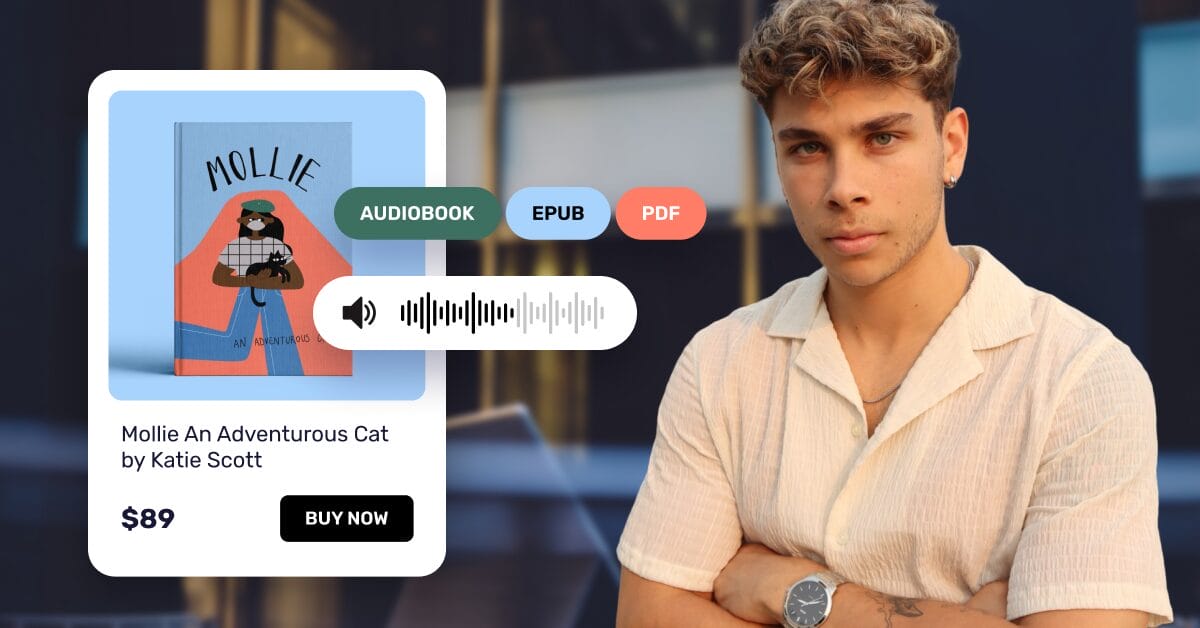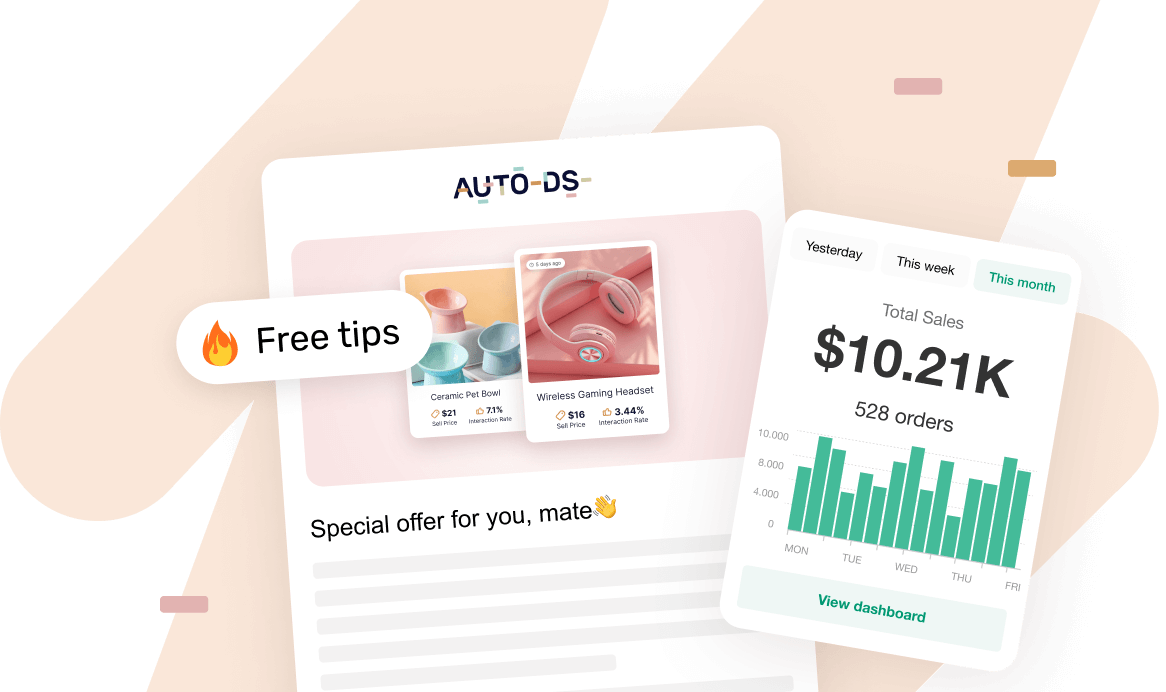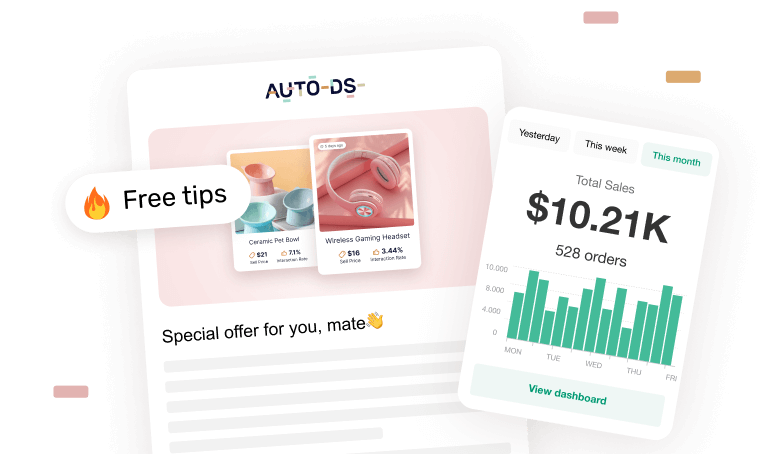Imagine selling a product that never runs out of stock, doesn’t require shipping, and arrives instantly to your customer’s inbox. Sounds beautiful, right? Welcome to the world of digital dropshipping products. These intangible goods (like ebooks, templates, or music files) have carved out a unique niche in eCommerce thanks to their low overhead and growing demand.
In 2025, the digital products niche is more than just a trend; it’s a real opportunity for dropshippers looking for scalable, hassle-free selling. And while is primarily designed for physical products, AutoDS supports hybrid sellers by automating order fulfillment and giving them the flexibility to offer digital extras that build brand value and boost perceived quality.
So, is this niche the right fit for you? This guide dives into why digital products are gaining momentum, which ones sell best, and how to dropship them successfully without the usual headaches.
Digital dropshipping products offer high margins, no shipping hassle, and instant delivery, ideal for scalable, low-overhead selling.
Top-selling digital items include ebooks, templates, presets, and online courses, all in-demand across platforms like Etsy and Shopify.
Success depends on niche focus, smart pricing, and standout presentation using visuals, bundles, or micro-courses.
Automation tools streamline delivery and order flow, while platforms like AutoDS can support hybrid stores with digital bonuses.
Challenges like piracy, refunds, and licensing require a clear strategy, but the potential makes this niche well worth exploring.
Why Dropship Digital Products in 2025?
Digital products have become a powerhouse niche for dropshippers, and it’s no surprise why. First off, fulfillment costs are almost nonexistent. There’s no inventory to manage, no warehouses to rent, and absolutely no shipping headaches to deal with. This alone slashes many of the traditional barriers of eCommerce.
Add to that the fact that digital goods offer some of the highest profit margins around. Once the product is created or licensed, selling it again costs next to nothing, making every sale mostly pure profit. Plus, instant delivery means customers get their purchase right away, boosting satisfaction and cutting support tickets.
The trend is clear: platforms like Etsy, Gumroad and Shopify are lighting up with digital downloads, templates, and online courses. Google Trends shows rising searches for digital planners, stock photos, and digital art, while viral TikTok clips push sales through the roof. And if you’re exploring the best niches for dropshipping in 2025, digital products should definitely be on your radar, they’re not only profitable but also eco-friendly: no packaging, no emissions, just pure digital flow.
Best Digital Products to Dropship
Not all digital goods are created equal: some have better margins, bigger audiences, or lower refund risks than others. If you’re just getting started (or looking to expand your offer), here are some of the most in-demand and beginner-friendly digital products worth exploring:
Ebooks & How-To Guides
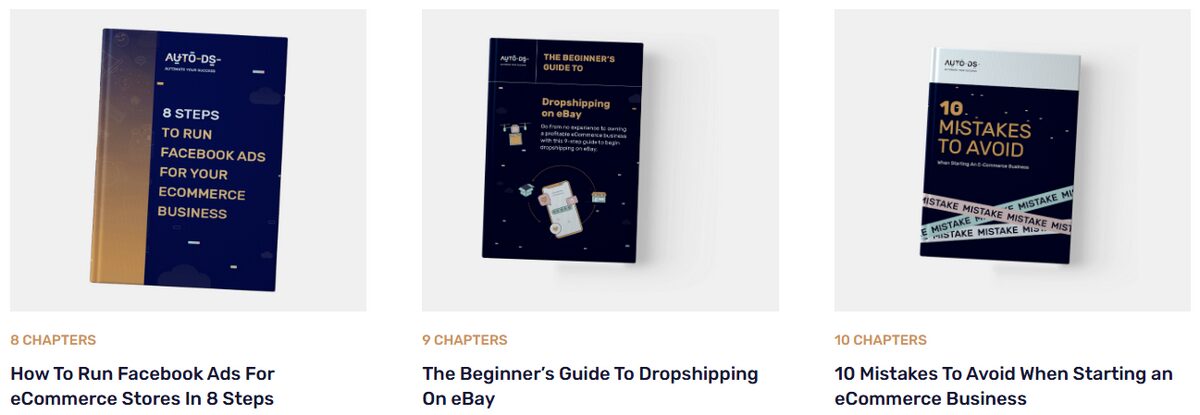
Digital books or step-by-step guides are a classic for a reason. Whether you write them yourself or license existing content, they’re perfect for trending niches like self-help, finance, or fitness. Easy to deliver and even easier to scale.
They’re also easily distributed on major marketplaces like Etsy or Gumroad, or through your own dropshipping store. The key is finding a niche with consistent search demand (think “how to budget in your 20s” or “meal prep for beginners.”) You can even bundle ebooks with printable worksheets, checklists, or exclusive bonuses to increase perceived value.
Canva Templates
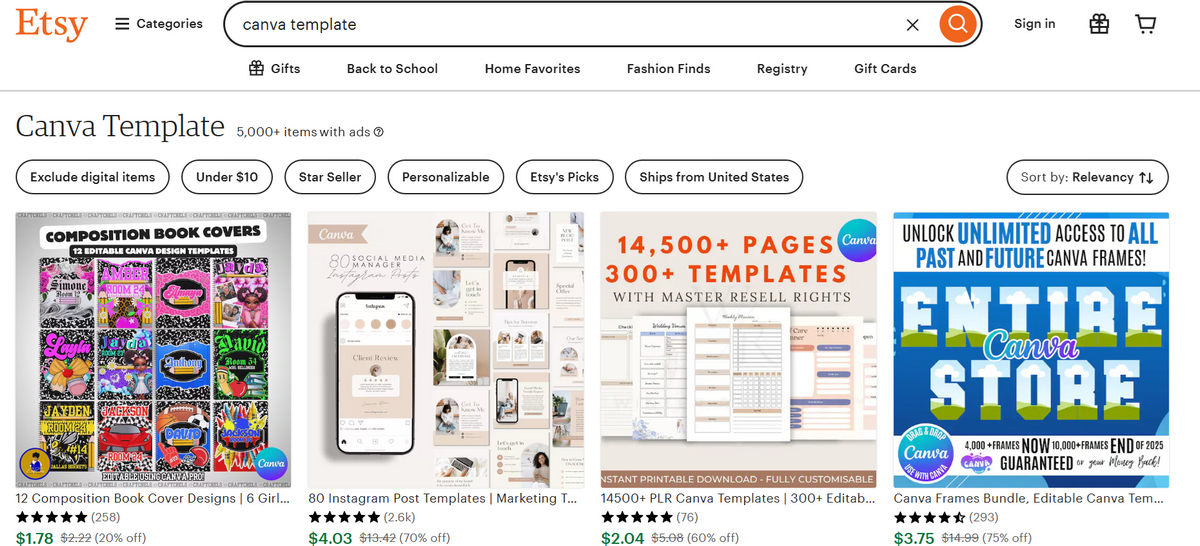
From social media posts to resumes and pitch decks, Canva templates help buyers save time and look polished. They’re hot sellers on Etsy and Gumroad, especially if you target specific audiences like small biz owners or job seekers.
The beauty of templates is that one design can serve hundreds of buyers. And since Canva is beginner-friendly, most customers don’t need design skills, they just plug in their content and go. Perfect for creators looking to sell repeatable value.
Printable Planners & Journals
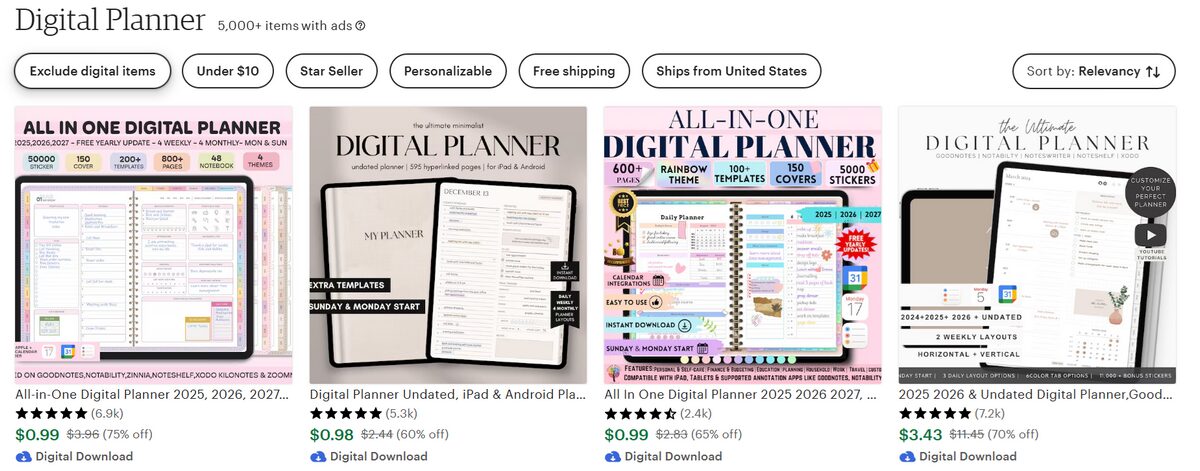
Think budget trackers, fitness logs, meal planners: you name it. These printable PDFs are easy to create and personalize, making them a favorite for buyers who love organizing life the analog way.
Seasonal bundles (like “New Year Goal Planners” or “Holiday Budget Kits”) tend to perform especially well. And because printing is done by the customer, there’s zero cost on your end after the initial design. Win-win situation, my friend.
Lightroom Presets & Filters
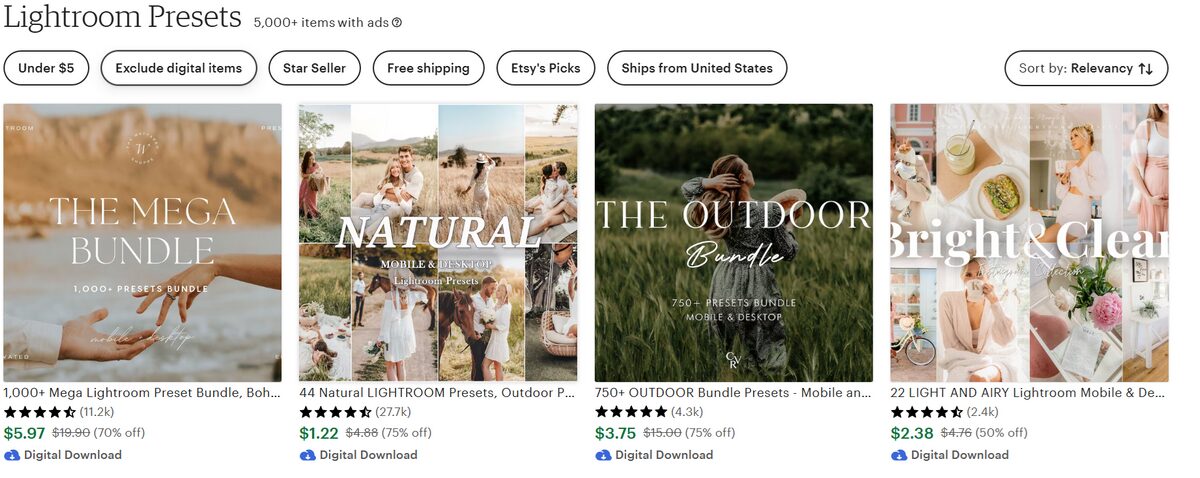
A hit among influencers and photographers, presets are a game-changer. These downloadable files allow users to apply stylish photo edits in one click, ideal for social media, blogs, or online shops. If you’ve got an eye for aesthetics, this is a great way to tap into the creator economy without dealing with physical inventory.
They’re especially popular on platforms like Etsy or Creative Market, and once created, they require zero maintenance. You can niche down by visual style (moody, clean, vintage, beachy) or by platform (e.g. “Instagram presets for food bloggers”).
🆕Beginner’s Tip: Offer before-and-after previews and usage tips to boost buyer confidence and reduce refund requests.
Digital Art & Stickers
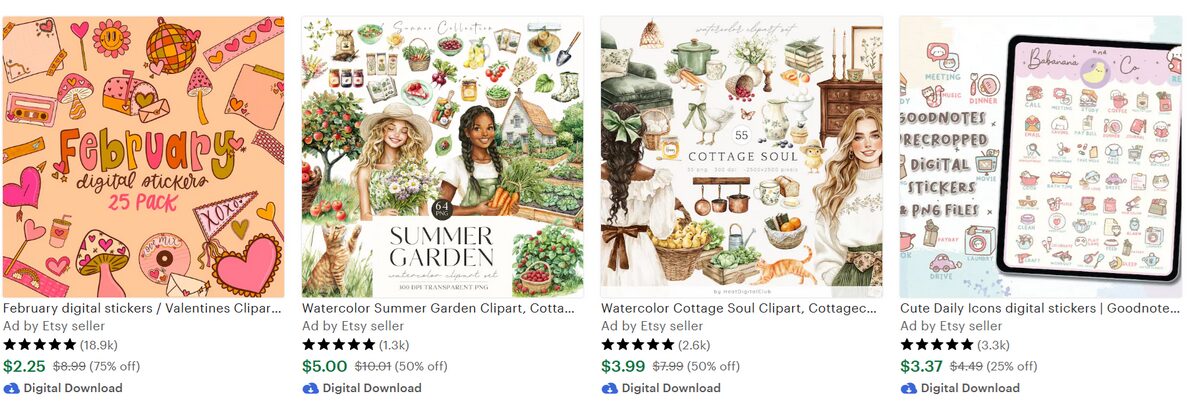
From wall prints to planner stickers, digital artwork is endlessly customizable. Sell in formats like PNG or SVG, and you’ll have a product that works for Cricut users, stationery lovers, and anyone decorating on a budget.
Trendy themes (like mental health products, astrology, or pop culture) often go viral. The best part? A single design can be repurposed into multiple formats (stickers, prints, wallpapers), expanding your offer without extra effort.
Online Courses or Mini Tutorials

Educational content is one of the most powerful digital products you can offer. Whether you’re teaching business skills, creative techniques, or everyday hacks, online courses have a high perceived value. Why? People see them as an investment in themselves, which makes premium pricing easier to justify.
They’re also incredibly flexible. You can partner with a content creator, repurpose your own expertise, or even outsource course creation entirely. Plus, once your material is recorded and uploaded, it becomes a source of passive income, generating sales with minimal upkeep. A well-targeted mini-course can go a long way toward building trust and community around your brand.
💡Pro Tip: Start small with micro-courses (under 1 hour) to test demand and pricing. Offering a teaser lesson for free is a great way to hook new buyers and build momentum without overcommitting upfront.
Music Loops & Sound Effects
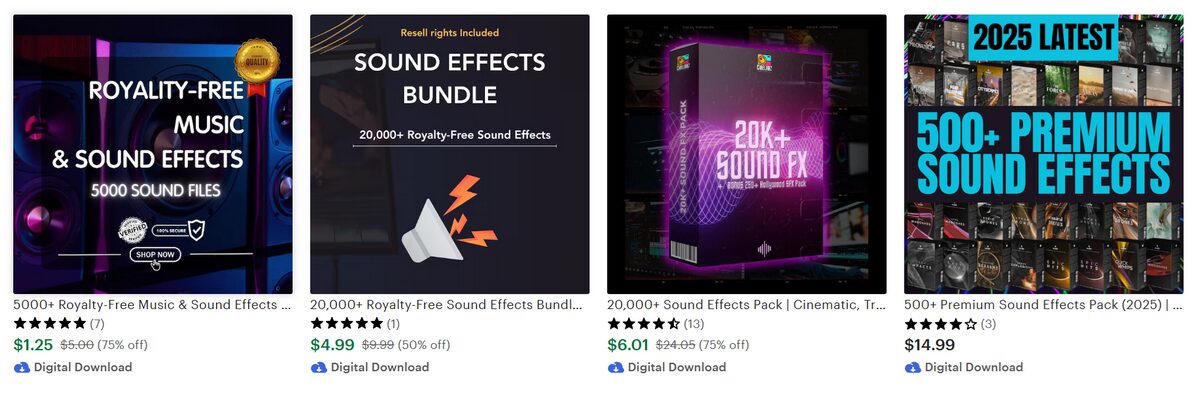
Podcasters, YouTubers, game developers and video editors are constantly looking for royalty-free audio. Offering loops, beats, or ambient effects gives them quality content and gives you a product with a long shelf life.
If you’re musically inclined or can license original tracks, this niche has huge potential. You can sell your sounds as individual files, curated packs, or bundles by mood, genre, or use-case (“TikTok background sounds”, “cinematic transitions”) to make discovery easy. Plus, there’s room to diversify: offer different licensing tiers depending on whether your customer is a casual creator or a commercial client.
Coding Snippets & Web Templates
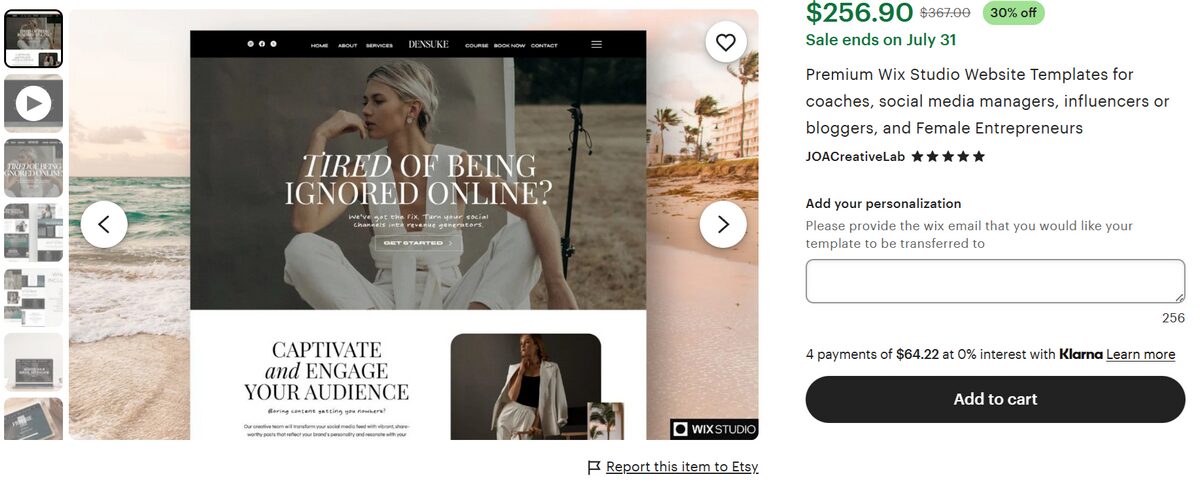
For developers, time is money, so ready-made code snippets, landing pages, or CMS templates are a huge win. From HTML email layouts to Shopify add-ons and WordPress themes, digital assets like these allow clients to launch projects faster without starting from scratch.
Even simple tools (like a “coming soon” page or mobile-responsive email template) can generate strong profit. On top of that, you can bundle premium updates or ongoing support, turning one-time sales into recurring revenue streams. To stand out from competitors, add clear documentation and bonus assets (like icon sets or font pairings) and you’ll have the job done.
You need a system that consistently brings winning products to test without you doing any work. Skip the grind and sign up for AutoDS to start leveraging cutting-edge fulfillment and backend data. – Nathan Nazareth, a self-made 23-year-old entrepreneur.
How to Dropship Digital Products Successfully
So, you’ve picked a product and spotted the potential. But how do you actually make digital dropshipping work? Good news: launching a digital product store doesn’t require coding skills, deep pockets, or a warehouse full of stock.
It does, however, take some planning, the right tools, and a few smart decisions along the way. Here’s a step-by-step roadmap to help you go from idea to income without losing your sanity (or your margins).
Choose a Digital Niche
Start with a niche you either know well or find genuinely interesting. Whether it’s fitness planners, resume templates, or audio loops, narrowing your focus helps you create (or source) more tailored, high-quality products. Plus, a clear niche makes it easier to brand your store and connect with a specific audience.
Don’t overthink it! Look at what’s already trending on Etsy, TikTok, or even Reddit. The goal isn’t to reinvent the wheel, but to offer a fresh spin on what people are already looking for.
Decide Whether to Create, License, or Partner
Not a designer or writer? No problem. You can create your own digital products if you’ve got the skills, but many successful sellers license existing ones or collaborate with creators. Sites like Creative Market, PLR repositories, or working directly with freelancers can help you source high-quality assets legally.
- Creating your own content offers control and uniqueness, but takes time.
- Licensing lets you start faster, but be sure to read the fine print.
- Finally, partnerships are great if you want to combine your marketing skills with someone else’s creativity.
Whichever route you take, always double-check usage rights. And make sure you’re not selling something already available for free elsewhere: value is key.
Pick A Platform
Where you sell matters. Choose a platform based on your product type, target audience, and how much customization or analytics you want.
Shopify gives you full control and branding potential, while Etsy brings instant traffic with a handmade/creative vibe. Gumroad is simple and direct, ideal for solo creators.
Beginner’s Tip: Not sure which platform to choose in 2025? Check out this Shopify vs Etsy comparison.
And don’t be afraid to test more than one, many digital sellers diversify to reach broader audiences.
Set Up Automated Delivery Tools
One of the biggest perks of digital dropshipping? Instant delivery. Use apps and integrations to ensure your products land in your buyer’s inbox the second they hit “purchase.”
Fast delivery equals happy customers and fewer refund requests. It also adds a layer of professionalism to your store, showing that you’ve got your backend dialed in, even if you’re just starting out.
Price Your Products Smartly
Just because digital goods are “intangible” doesn’t mean they should be priced like freebies. Base your pricing on perceived value, competitor benchmarks, and effort invested. Bundles and tiered pricing (e.g., personal vs. commercial use) can increase your average order value. Also, high-quality content can justify premium pricing, especially if it saves time or solves a real problem.
Finally, remember to factor in platform fees, transaction charges, and potential ad spend. A $5 item may sell fast, but a $20 bundle might be more profitable long-term.
Promote via SEO, TikTok, Pinterest, or Email

Digital products thrive where visual and value-driven content rules. Use Pinterest to share product mockups, TikTok for short how-to or transformation videos, and SEO for long-term search visibility. A solid product won’t sell if no one sees it.
Start building an email list early, even a small list can generate repeat sales. Consider offering a freebie in exchange for email signups to get your marketing flywheel moving.
Consider Offering Bundles or Subscriptions
Bundles boost perceived value and help you sell more in one go. Instead of a single planner, offer a 3-month system. Instead of one resume template, package five styles for different industries.
Subscriptions are the next level. If you can create or curate fresh content monthly (like stock photos, new presets, or updated guides) consider offering a low-cost monthly plan. Predictable revenue means less stress and better scaling.
Challenges to Keep in Mind
Digital dropshipping might skip the shipping chaos, but it brings its own set of curveballs. And, of course, it’s better to know them upfront:
- Piracy & Unauthorized Sharing: Once a file is downloaded, it can be copied and distributed without your consent. Secure delivery platforms and licensing terms help protect your products.
- Higher Refund Potential: Since digital items can’t be “returned,” some buyers may take advantage of generous refund policies. Clear terms and customer support can help, but expect a slightly higher dispute rate than with physical products.
- Branding Matters More: With no physical packaging or shipping experience to impress, your brand identity, product design, and store presentation do all the heavy lifting. Without polish and credibility, even great products can be overlooked.
- Licensing & Copyright Issues: Selling content you didn’t create or don’t have proper rights to (like stock templates, software, or music) can quickly backfire. Always double-check license agreements, even for items sourced from marketplaces or suppliers.
Being upfront about these risks doesn’t just build credibility, it sets you up for success. The digital space is full of opportunity, but it rewards those who play it smart, stay compliant, and think long-term.
Can You Use AutoDS with Digital Products?
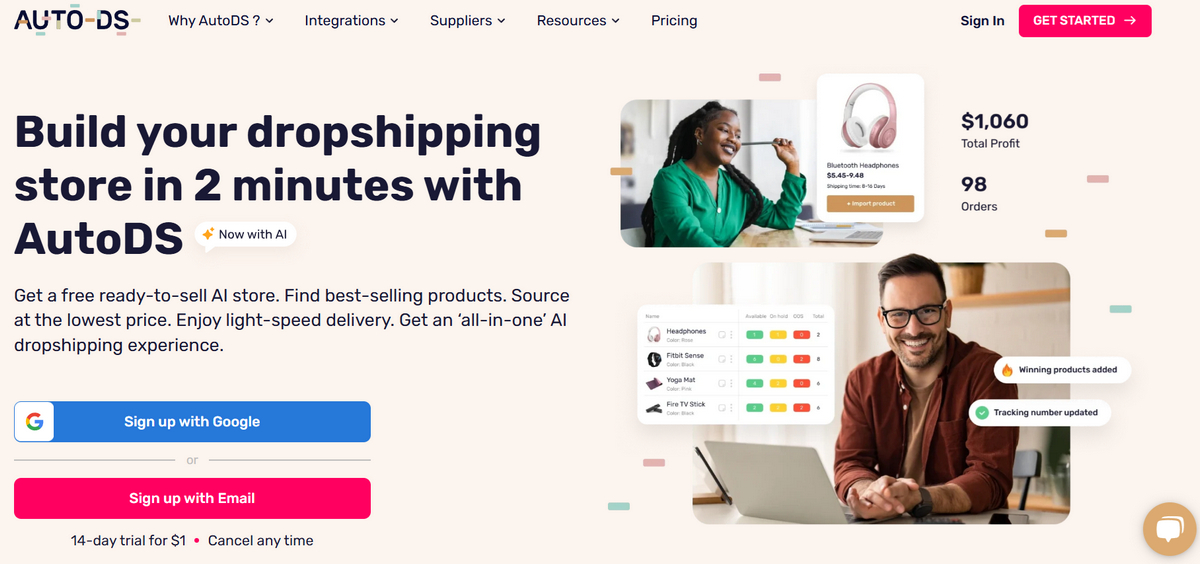
The short answer? Not directly, but there’s a smart workaround. AutoDS is primarily built for physical product dropshipping, with automation features that handle sourcing, inventory, order fulfillment, and tracking updates. So technically, it doesn’t support the sale or delivery of digital-only products.
That said, many dropshippers run hybrid stores using AutoDS to manage their physical items while offering digital bonuses through their selling platform. Think of it like this: you’re selling a set of resistance bands, and alongside every order, the customer receives a downloadable 10-day home workout plan: branded, valuable, and instantly accessible. More than selling a product, you’re offering a complete experience. This approach helps boost perceived value, differentiate your offer, and build brand trust, without stepping outside AutoDS’s automation sweet spot.
Ready to work with bundles and build a hybrid store? Try AutoDS’s 14-day trial for just $1 and test what works best for your niche and audience.
Frequently Asked Questions
What Is Digital Dropshipping?
Digital dropshipping is a business model where an entrepreneur sells digital products online without holding inventory. In this model, you can offer items like eBooks, software, digital art, or other intangible goods that are delivered electronically to customers.
What Are The Best Digital Products To Dropship?
The best digital products to dropship include eBooks, digital art, templates, printable planners and online courses. These items tend to have strong profit margins and a growing market demand, making them excellent choices to help scale your dropshipping business.
Is It Legal To Dropship Digital Products?
Yes, dropshipping digital products is legal as long as you have the proper rights to sell them and avoid copyright infringement. Staying compliant with copyright laws and digital sales regulations is crucial to running a legitimate business.
How Do I Start A Digital Dropshipping Business?
Starting a digital dropshipping business involves setting up an online store, selecting profitable digital products to sell, marketing them effectively, and fulfilling orders through automated delivery systems or suppliers.
Is Selling Digital Products Better Than Dropshipping?
Actually, selling digital products and dropshipping digital products are essentially the same in practice. Both involve selling and delivering intangible goods without holding stock, so either way, the potential for profit is solid.
Is Digital Dropshipping Saturated?
No, digital dropshipping is not saturated. The market continues to grow, with increasing demand for digital goods, offering ample opportunities for new sellers to carve out their niche and generate steady sales.
Conclusion: Is the Digital Products Niche Right for You?
If you’ve made it this far, you probably already have a good feeling about it. Indeed, digital dropshipping products offer one of the leanest, most scalable paths in eCommerce: no stock, no shipping, and plenty of room for creativity.
Of course, standing out takes more than a good idea. It requires strategy, branding, and products that actually deliver value. But for creatives, educators, and sellers looking to diversify or simplify, it’s a seriously compelling opportunity.
And if you’re thinking of mixing digital with physical products, here’s where smart automation comes in: AutoDS helps hybrid sellers streamline physical order fulfillment, making room to focus on digital bonuses that build trust and increase perceived value. So before jumping in, do your research, explore the best platforms, and think about how tools support your workflow. The future of dropshipping is flexible, and digital is a big part of it.
Want to learn more about the world of dropshipping? Check out the following articles and boost your knowledge:






